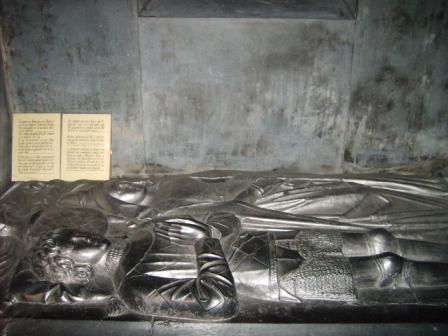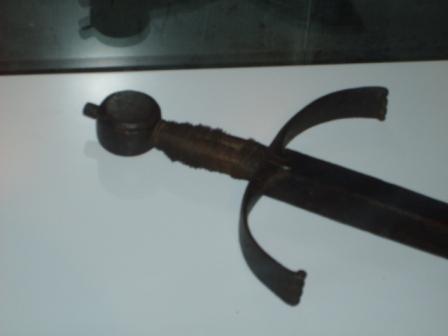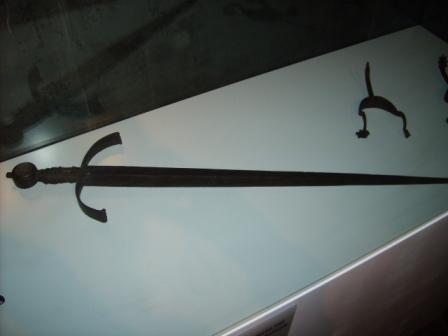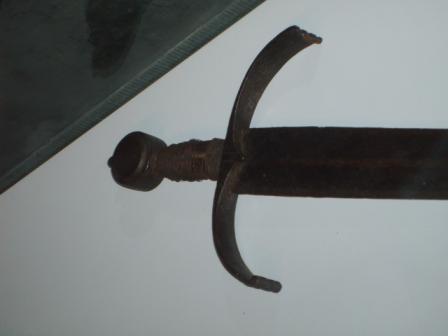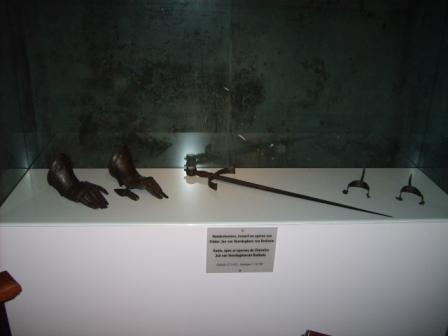Posts: 66 Location: Flanders, Belgium
Tue 20 May, 2008 1:53 am
Sword of Jan Van Dadizele
Posts: 1,265 Location: Malaysia
Tue 20 May, 2008 9:05 am
Re: Sword of Jan Van Dadizele
Jeroen,
To me van Dadizele's sword is authentic. I think this is a broadsword, judging by its blade.
Posts: 88 Location: England
Tue 20 May, 2008 9:37 am
Looks real enough to me ,could always do with seeing it first hand.
First impressions make me think it is an xviii possibly an xv,although the heavily curved guard is far more common on an xviii
regards
M.
Posts: 30 Location: U.S.
Tue 20 May, 2008 3:36 pm
I am inclined to agree that it is likely authentic, but difficult to say by photos. From what I can see the weapon seems to reflect patination with good age, and stylistically it seems right for the period. The sharp taper on diamond section blade with strong central ridge seems to correspond to a similar sword in the
Wallace Collection (A495) which is stated Italian c.1490. The one in the Wallace has similar forward curved quillons, but cannot tell if the wide cross section exists on it.
In the Wallace example, Mann notes that it appears the hilt, of somewhat similar form is modern restoration, and more ornate. The very simple discoid pommel, and workmanlike guard on this suggest it is original. There was considerable trade between Italy and Flanders in these times, and arms and armour from Italy would not have been unusual,.Tthough the Wallace example slightly antedates the Dadizele example, the form would likely have existed earlier, and with this I would presume authenticity.
Thank you for posting this Jeroen! Its really nice that you and others post these great examples in museums that I know I will likely never see, and really appreciate the opportunity to see these great pieces.
Best regards,
Jim
Posts: 354 Location: Dijon
Tue 20 May, 2008 6:15 pm
The blade might be.
The cross guard and pommel (dismising the hilt) might look dubious.
Buit it'd need a closer examination
Posts: 66 Location: Flanders, Belgium
Wed 21 May, 2008 2:04 am
Thanks for all your replies,
I have found another picture in the book Dadizele by Jozef Dessein.
Jeroen Averhals
 Attachment: 47.48 KB
Attachment: 47.48 KB
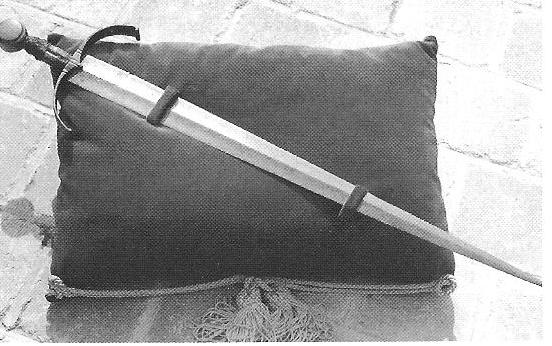
Posts: 30 Location: U.S.
Wed 21 May, 2008 7:36 am
Thanks Jeroen for the additional photo.
I think Fabrice is correct in being cautious in assessment as these swords in museums presented for display associated with important personages or events are often restored or remounted in varying degree. For example the swords attributed to El Cid in the Royal Armoury in Madrid and others.
While presuming dark age coloring or patina looks correct in photos, there is no comparison to actual handling of the weapon for authentication.
Posts: 434 Location: Indianapolis, IN
Wed 21 May, 2008 7:46 am
Well, regardless of when the entire package as it looks now was completed, it sure is pretty. This is a very good thread so far, thanks for posting it!
Posts: 9,570 Location: Dayton, OH
Wed 21 May, 2008 8:12 am
The gauntlets have a look, to me at least, that is more 16th century than 15th. Does anyone else share that opinion?
Posts: 4,194 Location: Northern VA,USA
Wed 21 May, 2008 8:19 am
| Chad Arnow wrote: |
| The gauntlets have a look, to me at least, that is more 16th century than 15th. Does anyone else share that opinion? |
Almost definately.
The sword's guard looks odd to me. That isn't to say it isn't authentic, I just have never seen one quite like it before, being very wide if you looked at it from above.
Posts: 30 Location: U.S.
Wed 21 May, 2008 4:06 pm
I finally dragged out the monster! ("Armi Bianchi Italiene", Boccia & Coelho....its a huge volume!) and looked through it. The diamond section blade decidedly Italian and of 15th century, but the hilt seems to correspond more to Italian hilts of c.1500-20 (in profile at least). I am not familiar what hilt forms would have been indiginous to that period in Flanders, but again, the wide flat shape seems unusual.
I wonder if this might be a Flemish interpretation of the Italian style hilts ?
Last edited by Jim McDougall on Wed 21 May, 2008 6:38 pm; edited 1 time in total
Posts: 301 Location: Brisbane, Australia
Wed 21 May, 2008 4:40 pm
Re: Sword of Jan Van Dadizele
| Jeroen Averhals wrote: |
Hail,
Jan van Dadizele was a 15th century Flemish nobleman who led the Flemish town militia to victory against the french army at the battle of Guinegate at the 7th of august 1479.
His tomb is in the church at Dadizele together with his sword.
What type of sword is this and do you think it is authentic?
thanks,
Jeroen Averhals |
Hi Jeroen,
Do you know if this is the Sword that is reproduced by Deepeka called the " Guinegate " Sword ? The story of Jan of Dadizele sounds interesting and so I tried to Google it but got nothing. Wikipedia had nothing also.
Some Belgian sites did have a story about a guy named Jan associated with the Basiliek van Dadizele ( The Basilica of Our Lady in Dadizele, Flanders ? ) ... but the story had nothing to do with fighting the French !
Can you shed some light on this story for us ? Do you know of any websites about this story ? ( I have Firefox - Lingo, so translation is quick and easy ! )
Thanks....
Merv
Posts: 9,570 Location: Dayton, OH
Wed 21 May, 2008 5:11 pm
Re: Sword of Jan Van Dadizele
| Merv Cannon wrote: |
Hi Jeroen,
Do you know if this is the Sword that is reproduced by Deepeka called the " Guinegate " Sword ? The story of Jan of Dadizele sounds interesting and so I tried to Google it but got nothing. Wikipedia had nothing also.
|
Deepeeka's sword is based on MRL's discontinued Guingate sword. It's not based off the sword shown above. According to the MRL sales spiel for its version on reliks.com:
| Quote: |
| We ran across the original in an auction and were impressed by its sheer loveliness. We were fortunate to be able to photograph it in order to replicate it for our customers. |
Posts: 66 Location: Flanders, Belgium
Fri 23 May, 2008 4:17 am
Hail,
Thanks for all your comments. I have attached another picture of the gauntlets.
Jeroen Averhals
 Attachment: 54.59 KB
Attachment: 54.59 KB
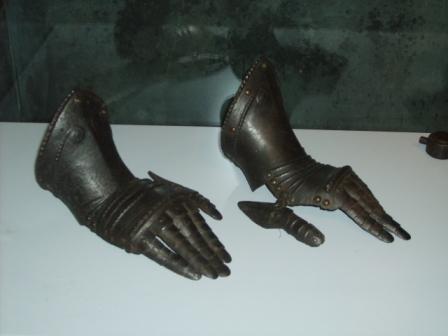
Posts: 66 Location: Flanders, Belgium
Thu 05 Jun, 2008 11:52 pm
Hail,
I reread the book 'De slag bij Guinegate 7 augustus 1479' (the battle of Guinegate 7th of August 1479) by J.F. Verbruggen and tried to tell the story of the battle.
Karel de Stoute/Charles the Bold died in the Battle of Nancy en Maria of Burgundy became the Duchess, after many defeats Burgundy was not enough protected against the French army. The French army under Louis XI counted in 1476 2486 heavily armoured knights, 2486 lightly armoured knights, 5692 mounted archers and 16000 franc-archers (archers, crossbowmen and pikemen (pikes and halberds).
Maria of Burgundy abolished taxes and started the defence, the soldiers in the threatened cities were paid on monthly bases so they wouldn’t damage the countryside, if captured their ransom would be paid, if the soldiers died their family would receive enough grain for the rest of their lives.
France started to attack cities in Artesie and marched to Saint-Omer (nowadays the north of France) and the Flemish city militia prepared for battle.
Karel de Stoute never used the city militia in his army because he preferred mounted men but his daughter had no other choice then the use of these men.
The militia of Ghent (1587 men), Bruges (1659 men) and nobility (700-800 horses) set up camp in Spiere lead by Jan of Gelre, 18th of June arrived Jan of Luxemburg with 2000 men infantry and 2000 men cavalry. Doornik/Tournai was occupied by the French and the 26/27 June the Flemish army attacked Doornik and looted the suburbs, while retreating with the loot Jan van Gelre was killed by the French defenders. This caused troubles on the Flemish side, Ghent’s city militia left, so did Bruges’, they left tents and food which were taken by the French army who heard of the retreat of the city militia.
The Flemish cities ordered all the militia to return to their camp in Spiere, so they did. While they ware setting up camp, not all had returned, 1600 French cavalry attacked the 3/4000 Flemish who were worried they couldn’t resist the cavalry. They defended well but not for long, 100 Flemish were killed, 950 captured and the others fled.
Maria of Burgundy married Maximiliaan of Austria who became the new Duke of Burgundy, who would lead the troops and defended the borders. At his arrival in Flanders with 800 men he wanted money to pay his knights and mercenaries; he wanted 500000 mounted men…
France kept marching and started to kill near Ieper/Ypres, Maximiliaan ordered Jan van Dadizele to get as many troops as he could get and defend the bridges over the river Leie.
Maximiliaan started his campaign and wanted to recruit 5/6000 Swiss mercenaries. The people of Flanders wanted to pay for the defence of their country but the money shouldn’t be used for the hiring of mercenaries, it should be used for paying the Flemish city militia.
Jan van Dadizele started raising his army as a police force, the men were raised around Dadizele, about 5600. When news came of soldiers of their own army looting, plundering, raping, killing,… the militia could arrest and even execute the looters.
May 1479 Maximiliaan appointed Jan van Dadizele as captain-general of the Flemish troops. Maximilaan wanted Jan to raise an army of 150000 fighting men…
There had been a truce between Louis XI and Maximiliaan that ended 11 July 1479, Louis had gathered troops near the border and Maximiliaan started the hostilities by attacking Terwaan, a city occupied by the French from which they could easily raid Flanders. The siege began but soon they heard that the French army was coming. Maximiliaan decided to break up the siege to move to a better location.
Near Enguinegatte the armies sighted each other and Maximiliaan sent some cavalry tot attack the French vanguard while the Burgundian army was still marching. When the Burgundian army reached the hill of Enguinegatte they saw the French army standing on another hill.
The French army counted 20 compaignies of each 100-400 men cavalry, the best in Europe; 20 compaignies of each 100-600 men infantry and 1000 men artillery, so 2000 heavy lances, 2000 light lances, 4000 mounted archers, 8000 franc-archers (archers, crossbowmen, pikemen).
The Burgundian army 825 heavy lances, 3000 English archers, 3000 archers, crossbowmen, arquebussiers, 825 light lances, 11000 Flemish pikemen and a 1000 men artillery.
Both armies had about 16000 soldiers both the Burgundian were outnumbered by the French cavalry.
The Burgundians moved around the French army so they would have the advantage of sun and wind during the battle.
Jan van Dadizele was only a noble lad but was knighted before the battle. The counts of Romont and Nassau lead the Flemish pikeman and placed dismounted Flemish noblemen between them. Before them stood the Burgundian artillery, after the cannons 3300 archers, crossbowmen, arquebussiers. On both sides next to the pikemen stood the Burgundian cavalry.
500 French lances followed by their mounted archers charged the Burgundian cavalry, avoiding the cannons and pikemen. In the first charge 300 Burgundian cavalry fled. Maximiliaan broke his lance on a French nobleman, captured another, dismounted and took place with the pikemen. Most of the Burgundian cavalry fled but some took place behind the pikemen, dismounted en stood with them.
The French attacked the Burgundian baggage train but they were defeated by the pikemen lead by Nassau. Another 400 French lances charged the baggage train and killed priests, women,… the soldiers defending the baggage joined the pikemen en the Burgundians lost their baggage train.
The French cavalry that wasn’t following the fleeing Burgundian cavalry attacked the Burgundian pikemen/archers/artillery together with the French archers and artillery. The two blocks of Flemish pikemen stood 100 wide, 50 deep. The pikeman stood calm, shoulder to shoulder while being shot by cannons, arquebussiers, archers, crossbownmen. Their long pikes of 13 to 20 feet kept the enemy at distance.
The French banded all their soldiers together en made a very powerful charge, they drove the Burgundian archers back, conquered the artillery and started to turn the cannons towards the pikemen. Romont understood that this was a decisive point of the battle and ordered both blocks to charge. They stepped forward with the archers at their flanks and back and marched towards the enemy. Their sudden and powerful attack surprised the French en the regained their artillery. They kept charging and forced the enemies to fight at a closer range and drove them back. They conquered the French artillery, marched on and even conquered the French baggage train. Maximiliaan en some of his noblemen found horses in the French camp, mounted and started to follow the fleeing French army assisted by the Flemish infantry.
The Burgundian army marched that day from dawn, fought from 14u00 till 20h00 and followed the fleeing French, no one could remember a battle of such duration.
Maximiliaan took no advantage of his victory and regained no more cities that were occupied by the French king, due to fear of betrayal, Flemish troops wanting to go home, no more money to pay the soldiers?
In September a new army was called to arms under Jan van Dadizele which conquered some cities and wanted a new battle against France but winter came and 15th october all the troops could go home. The French army raided to border and the Flemish put some troops there for defense. During winter and the next year were some raids but no battle.
Jeroen Averhals
You
cannot post new topics in this forum
You
cannot reply to topics in this forum
You
cannot edit your posts in this forum
You
cannot delete your posts in this forum
You
cannot vote in polls in this forum
You
cannot attach files in this forum
You
can download files in this forum
